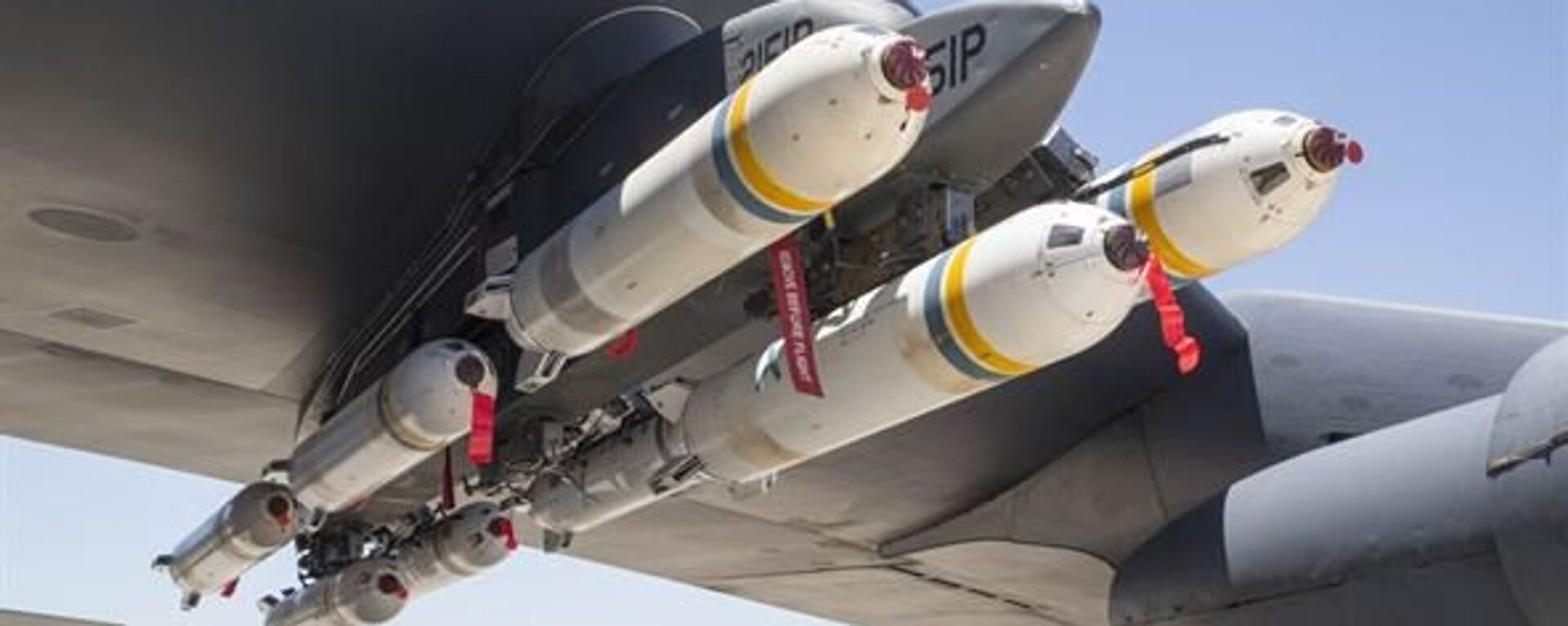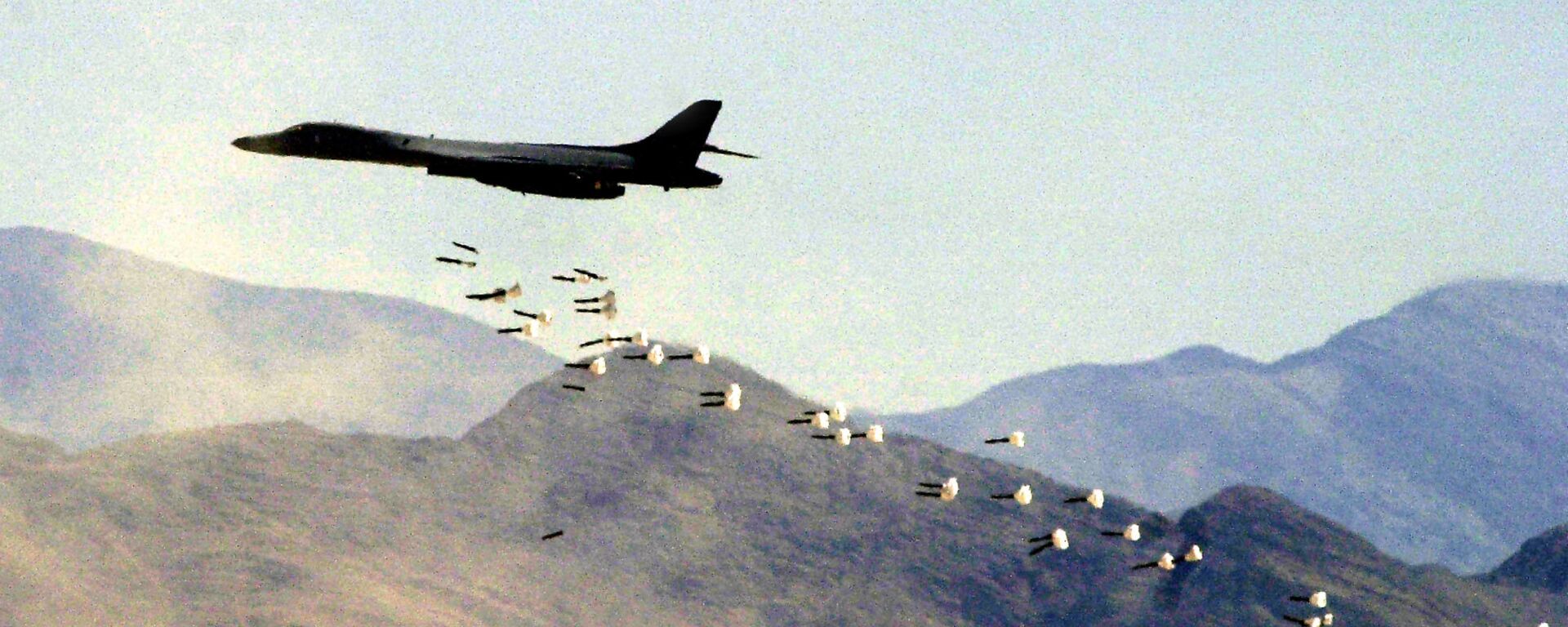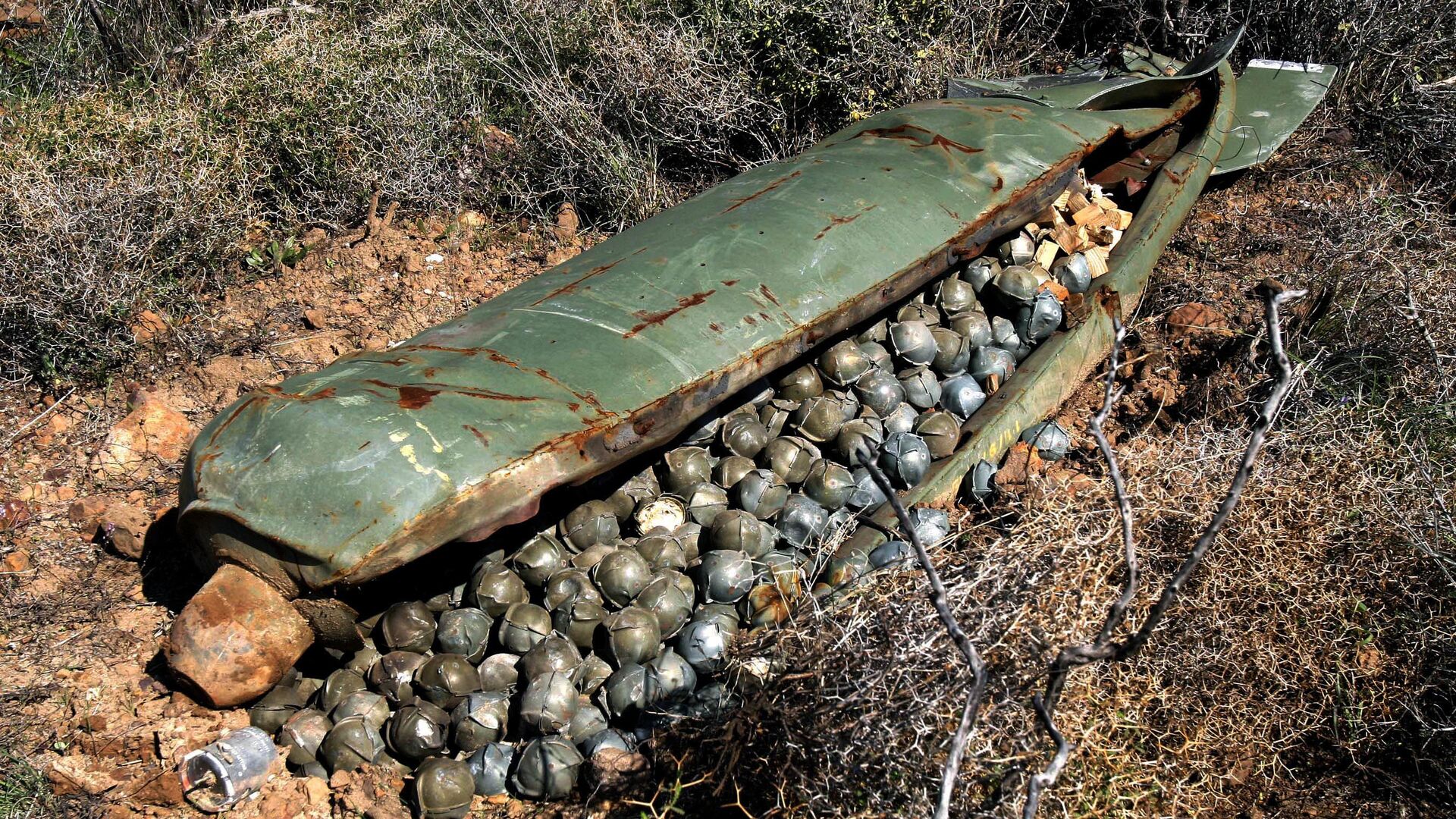https://sputnikglobe.com/20230307/lethal-bomblets-what-are-cluster-munitions-and-why-does-ukraine-want-them-1108149745.html
Lethal Bomblets: What Are Cluster Munitions and Why Does Ukraine Want Them?
Lethal Bomblets: What Are Cluster Munitions and Why Does Ukraine Want Them?
Sputnik International
The use of cluster munitions is prohibited under the relevant convention, to which neither the US nor Ukraine are a party.
2023-03-07T14:40+0000
2023-03-07T14:40+0000
2023-03-07T14:40+0000
sputnik explains
us
ukraine
cluster bombs
nato
munitions
war
special operation
https://cdn1.img.sputnikglobe.com/img/105986/89/1059868925_0:114:2700:1633_1920x0_80_0_0_e3e3cd6177c07f4d337472f806df645f.jpg
Kiev is considering using US-made cluster munitions against Russian forces who continue their special military operation in Ukraine, a US media outlet has reported.The outlet cited Jason Crow and Adam Smith, who both serve on the House of Representatives Armed Services Committee, as saying that Ukraine is seeking the US MK-20 cluster bomb, as part of Washington’s military assistance to Kiev. So what are cluster munitions and why are Ukrainian authorities so eager to acquire this type of weapon that is banned in scores of countries? Sputnik explores.What is a Cluster Bomb?A cluster munition or bomb is an extremely lethal weapon that contains multiple explosive submunitions, or bomblets.Such bombs are typically dropped from aircraft or fired from the ground or sea, opening up in mid-air to release tens or hundreds of submunitions, which can saturate an area up to the size of several football fields, or more than 300 meters.Opponents explain that when cluster bomblets scatter they can maim and kill civilians and have high failure rates, with duds posing a danger for years after a conflict ends.What About the MK-20?The MK-20 Rockeye II, also known as the CBU-100 Cluster Bomb, is an air-launched, conventional free-fall weapon manufactured in the US.The 222 kg bomb, which is designed to mainly target enemy armored vehicles, was introduced in 1986 to replace the earlier cluster bombs used by the US Air Force (USAF) in the 1955-1975 Vietnam War.Why Does Kiev Want to Get MK-20s?The Ukrainian government reportedly expressed hope that the MK20 cluster bombs will give Kiev "an edge in the grinding fight against Russian forces in eastern Ukraine."Why is Kiev So Sure of Legality of Cluster Bomb Supplies?Speaking on the sidelines of the 2023 Munich Security Conference last month, Ukrainian Infrastructure Minister Alexander Kubrakov claimed that the US and its partners possess cluster munitions "for millions of shots."Ukraine's Foreign Minister Dmitry Kuleba, for his part, recalled that Kiev is not a signatory to the Convention on Cluster Munitions, which is why he argued that the US providing Ukraine with such weaponry is purportedly in sync with international law.Textron Systems Corporation stopped producing the MK-20s in 2016 after the US halted sales to Saudi Arabia, but an unnamed congressional aide told an American media outlet that there are more than one million cluster sub-munitions in the US military stockpiles.Are Cluster Bombs Prohibited?The Convention on Cluster Munitions (CCM) is an international treaty that bans all use, transfer, production, and stockpiling of cluster bombs. The CCM also establishes a framework to support victim assistance, clearance of contaminated sites, risk reduction education, and stockpile destruction.The convention was adopted on May 30, 2008, in Dublin before coming into force on August 1, 2010. As of February 2022, a total of 123 states remain committed to the goal of the document and are obliged "never under any circumstances" to:It’s worth noting that neither Ukraine nor the US are signatories to the CCM.Where Did US Use Cluster Bombs? Between 1964 and 1973, the USAF used cluster bombs during the Indochina Wars, which saw 285 million US cluster submunitions dropped on targets in Vietnam, Laos and Cambodia, killing tens of thousands of people.Between 60,000 and 80,000 cluster bombs were dropped on Iraqi forces’ positions by US, British, and French aircraft during the Gulf War in 1991.During the 1999 NATO bombing of then-Yugoslavia, about 2,000 cluster munitions containing more than 380,000 bomblets were used by the US and its allies against Yugoslav security forces and civilian population. At least 25 civilians were reportedly killed as a result of the cluster bomb strikes during the three-month NATO operation.In addition, the Pentagon dropped 1,200 cluster bombs containing 248,000 submunitions in Afghanistan between 2001 and 2002.In the spring of 2003, the first three weeks of hostilities in Iraq, US-British coalition forces used almost 13,000 cluster bombs containing approximately two million sub-munitions, with some of them reportedly targeting civilians. In addition, the US tested a new 500 kg laser-guided cluster bomb in Iraq in April 2003.
https://sputnikglobe.com/20221208/us-considering-ukraines-request-to-provide-cluster-munitions-reports-suggest-1105195650.html
https://sputnikglobe.com/20200903/us-tests-next-generation-fragmentation-bomb-as-viable-substitute-for-cluster-munitions-1080360316.html
ukraine
Sputnik International
feedback@sputniknews.com
+74956456601
MIA „Rosiya Segodnya“
2023
Oleg Burunov
https://cdn1.img.sputnikglobe.com/img/07e4/09/0b/1080424846_0:0:2048:2048_100x100_80_0_0_3d7b461f8a98586fa3fe739930816aea.jpg
Oleg Burunov
https://cdn1.img.sputnikglobe.com/img/07e4/09/0b/1080424846_0:0:2048:2048_100x100_80_0_0_3d7b461f8a98586fa3fe739930816aea.jpg
News
en_EN
Sputnik International
feedback@sputniknews.com
+74956456601
MIA „Rosiya Segodnya“
Sputnik International
feedback@sputniknews.com
+74956456601
MIA „Rosiya Segodnya“
Oleg Burunov
https://cdn1.img.sputnikglobe.com/img/07e4/09/0b/1080424846_0:0:2048:2048_100x100_80_0_0_3d7b461f8a98586fa3fe739930816aea.jpg
cluster bombs, use of cluster munitions by the us, ukraine's plans to get cluster bombs from the us
cluster bombs, use of cluster munitions by the us, ukraine's plans to get cluster bombs from the us
Lethal Bomblets: What Are Cluster Munitions and Why Does Ukraine Want Them?
Even though more than 100 countries are banned from using cluster munitions under a convention, the US never hesitated to use such weapons in its military campaigns.
Kiev is considering using US-made cluster munitions against Russian forces who continue their
special military operation in Ukraine, a US media outlet has reported.
The outlet cited Jason Crow and Adam Smith, who both serve on the House of Representatives Armed Services Committee, as saying that Ukraine is seeking the US MK-20 cluster bomb, as part of
Washington’s military assistance to Kiev.
So what are cluster munitions and why are Ukrainian authorities so eager to acquire this type of weapon that is banned in scores of countries? Sputnik explores.
A cluster munition or bomb is an extremely lethal weapon that contains multiple explosive submunitions, or bomblets.
Such bombs are typically dropped from aircraft or fired from the ground or sea, opening up in mid-air to release tens or hundreds of submunitions, which can saturate an area up to the size of several football fields, or more than 300 meters.

8 December 2022, 12:34 GMT
Opponents explain that when cluster bomblets scatter they can maim and kill civilians and have high failure rates, with duds posing a danger for years after a conflict ends.
The MK-20 Rockeye II, also known as the CBU-100 Cluster Bomb, is an air-launched, conventional free-fall weapon manufactured in the US.
The 222 kg bomb, which is designed to mainly target enemy armored vehicles, was introduced in 1986 to replace the earlier cluster bombs used by the US Air Force (USAF) in the 1955-1975 Vietnam War.
Why Does Kiev Want to Get MK-20s?
The Ukrainian government reportedly expressed hope that the MK20 cluster bombs will give Kiev "an edge in the grinding fight against Russian forces in eastern Ukraine."
Adam Smith, the top Democrat on the House Armed Services Committee, was cited by a US media outlet as saying that the Ukrainian military believes these submunitions "have better armor-piercing capability" than the weapons it has been dropping from drones."
Why is Kiev So Sure of Legality of Cluster Bomb Supplies?
Speaking on the sidelines of the 2023 Munich Security Conference last month, Ukrainian Infrastructure Minister Alexander Kubrakov claimed that the US and its partners possess cluster munitions "for millions of shots."
Ukraine's Foreign Minister Dmitry Kuleba, for his part, recalled that Kiev is not a signatory to the Convention on Cluster Munitions, which is why he argued that the US providing Ukraine with such weaponry is purportedly in sync with international law.
Textron Systems Corporation stopped producing the MK-20s in 2016 after the US halted sales to Saudi Arabia, but an unnamed congressional aide told an American media outlet that there are more than one million cluster sub-munitions in the US military stockpiles.
Are Cluster Bombs Prohibited?
The Convention on Cluster Munitions (CCM) is an international treaty that bans all use, transfer, production, and stockpiling of cluster bombs. The CCM also establishes a framework to support victim assistance, clearance of contaminated sites, risk reduction education, and stockpile destruction.
The convention was adopted on May 30, 2008, in Dublin before coming into force on August 1, 2010. As of February 2022, a total of 123 states remain committed to the goal of the document and are obliged "never under any circumstances" to:
develop, produce, otherwise acquire, stockpile, retain or transfer to anyone, directly or indirectly, cluster munitions;
assist, encourage or induce anyone to engage in any activity prohibited to a State party under current Convention.
It’s worth noting that neither Ukraine nor the US are signatories to the CCM.
Where Did US Use Cluster Bombs?
Between 1964 and 1973, the USAF used cluster bombs during the Indochina Wars, which saw 285 million US cluster submunitions dropped on targets in Vietnam, Laos and Cambodia, killing tens of thousands of people.
Between
60,000 and 80,000 cluster bombs were dropped on Iraqi forces’ positions by US, British, and French aircraft during
the Gulf War in 1991.
During
the 1999 NATO bombing of then-Yugoslavia, about
2,000 cluster munitions containing more than
380,000 bomblets were used by the US and its allies against Yugoslav security forces and civilian population. At least 25 civilians were reportedly killed as a result of the cluster bomb strikes during the three-month NATO operation.

3 September 2020, 19:00 GMT
In addition, the Pentagon dropped 1,200 cluster bombs containing 248,000 submunitions in Afghanistan between 2001 and 2002.
In the spring of 2003, the first three weeks of
hostilities in Iraq, US-British coalition forces used almost
13,000 cluster bombs containing approximately two million sub-munitions, with some of them reportedly targeting civilians. In addition, the US tested a new 500 kg laser-guided cluster bomb in Iraq in April 2003.






